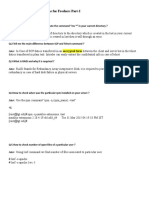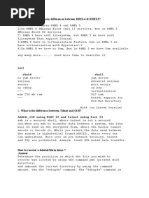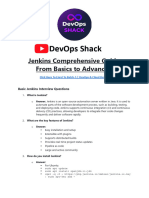Linux Administration - Linux Interview Questions 7
Linux Administration - Linux Interview Questions 7
Uploaded by
click2chaituCopyright:
Available Formats
Linux Administration - Linux Interview Questions 7
Linux Administration - Linux Interview Questions 7
Uploaded by
click2chaituOriginal Description:
Original Title
Copyright
Available Formats
Share this document
Did you find this document useful?
Is this content inappropriate?
Copyright:
Available Formats
Linux Administration - Linux Interview Questions 7
Linux Administration - Linux Interview Questions 7
Uploaded by
click2chaituCopyright:
Available Formats
Linux Administration
Useful tips and tricks for Linux Systems Engineers and Administrators
Home All Articles Linux Professional Institute Practice Test Linux Interview Questions About Me
Linux Interview Questions
In the past 12+ years I've been professionally involved with Linux Systems Engineering and Administration and I had the pleasure to be on both sides of the interviewing fence, quite a bit. The following is a collection of interview questions that I was either asked or I've asked a candidate for a Linux Systems Administrator or Engineer position. There are some networking and MySQL questions thrown in there for good measure. See if you can answer them all! Linux Questions: Q. Where are the file names stored on a file system? A. The actual file names are stored in the directory file they reside in. No surprise here as pretty much everything on Linux is a file. On most Linux distributions you can either cat or edit the directory name to see the file names that are within it, e.g cat /home, or vi /home Q. What is a Signal in Linux, and what signal is invoked when you use the kill command? What is the difference between kill and kill -9? A. A signal is a limited form of inter-process communication used in Unix, Unix-like, and other POSIX-compliant operating systems. It is an asynchronous notification sent to a process or to a specific thread within the same process in order to notify it of an event that occurred. When a signal is sent, the operating system interrupts the target process's normal flow of execution. The difference between invoking kill with no signal specified (which uses SIGTERM, number 15) and kill -9 is that the latter tries to kill the process without consideration to open files and resources in use. Q. What is a process? A. A process is an instance of an executing program. When a program is executed, the kernel loads the code of the program into virtual memory, allocates space for program variables, and sets up kernel bookkeeping data structures to record various information (such as process ID, termination status, user IDs, and group IDs) about the process. From a kernel point of view, processes are the entities among which the kernel must share the various resources of the computer. Q. What are the logically divided parts of a process? A. A process is logically divided into the following parts, known as segments: * Text: the read-only machine-language instructions of the program run by the process. * Data: initialized/uninitialized global and static variables used by the program; * Heap: an area from which memory (for variables) can be dynamically allocated at run time. The top end of the heap is called the program break; * Stack: a piece of memory that grows and shrinks as functions are called and return and that is used to allocate storage for local variables and function call linkage information; Q. What are the process states in Linux? A. Running: Process is either running or ready to run * Interruptible: a Blocked state of a process and waiting for an event or signal from another process * Uninterpretable: a blocked state. Process waits for a hardware condition and cannot handle any signal * Stopped: Process is stopped or halted and can be restarted by some other process * Zombie: process terminated, but information is still there in the process table.
Latest Articles
Installing OpenStack Folsom on Ubuntu Diagnosing kernel panics with Kdump Troubleshooting the "Out of socket memory" error Building a Load Balancer with LVS - Linux Virtual Server Configuring LXC using libvirt Building HA Load Balancer with Nginx and keepalived Creating apt repository with reprepro on Ubuntu Configuring LXC - Linux Containers Setting Up Linux cgroups Deploying GlusterFS Fun with redirecting file descriptors Load balancing Puppet with Apache mod_proxy and mod_passenger Accessing the contents of a KVM disk image file Red Hat to Debian Packaging conversion
Q. What is a Socket? A. A Socket is the combination of an IP address and a port number .Based on this combination, internet sockets deliver incoming data packets to the appropriate application process or thread. Q. How do you debug a running process or a library that is being called? A. strace -p PID ltrace libraryfile Q. How to see a memory map of a process, along with how much memory a process uses? A. pmap -x PID Q. You run chmod -x /bin/chmod, how do you make chmod executable again without copying it or restoring from backup? A. On Linux, when you execute an ELF executable, the kernel does some mapping and then hands the rest of process setup off to ld.so(1), which is treated somewhat like a (hardware backed) interpreter for ELF files, much like /bin/sh interprets shell scripts, perl interprets perl scripts, etc. And just like you can invoke a shell script without the executable bit via /bin/sh your_script, you can do: /lib64/ld-linux-x86-64.so.2 /bin/chmod +x /bin/chmod Q. Explain the TIME_WAIT state in a TCP connection, as displayed by netstat or ss. A. A TCP connection is specified by the tuple (source IP, source port, destination IP, destination port). The reason why there is a TIME_WAIT state following session shutdown is because there may still be live packets out in the network on its way to you. If you were to re-create that same tuple and one of those packets show up, it would be treated as a valid packet for your connection (and probably cause an error due to sequencing). So the TIME_WAIT time is generally set to double the packets maximum age. This value is the maximum age your packets will be allowed to get to before the network discards them. That guarantees that, before your allowed to create a connection with the same tuple, all the packets belonging to previous incarnations of that tuple will be dead. That generally dictates the minimum value you should use. The maximum packet age is dictated by network properties, an example being satellite lifetimes are higher than LAN lifetimes since the packets have much further to go. Q. What is Huge Pages in Linux and what use is there for them? A. Hugepages is a mechanism that allows the Linux kernel to utilize the multiple page size capabilities of modern hardware architectures. Linux uses pages as the basic unit of memory, where physical memory is partitioned and accessed using the basic page unit. The default page size is 4096 Bytes in the x86 architecture. Hugepages allows large amounts of memory to be utilized with a reduced overhead. To check: cat /proc/sys/vm/nr_hugepages. To set: echo 5 > /proc/sys/vm/nr_hugepages Q. What is a Master boot Record and how do you back it up and restore it? A. The MBR is a 512 byte segment on the very first sector of your hard drive composed of three parts: 1) the boot code which is 446 bytes long, 2) the partiton table which is 64 bytes long, and 3) the boot code signature which is 2 bytes long. To backup: dd if=/dev/sda of=/tmp/mbr.img_backup bs=512 count=1 To restore: dd if=/tmp/mbr.img of=/dev/sda bs=512 count=1 Q. Your server is using a lot of cached memory. How do you free it up short of rebooting? A. Kernels 2.6.16 and newer provide a mechanism to have the kernel drop the page cache and/or inode and dentry caches on command, which can help free up a lot of memory. To free page cache, dentries and inodes: echo 3 > /proc/sys/vm/drop_caches Q. How do you track new concurrent connections? A. Concurrent connections are the number of authenticated "handshakes" between a client and/or server during any given time before all communications have been disconnected whether by force or by refusal. You can run: modprobe ip_conntrack conntrack -E -e NEW Q. What is SYN flood and how can you detect it and mitigate it? A. A SYN flood is a form of denial-of-service attack in which an attacker sends a succession of SYN requests to a target's system in an attempt to consume enough server resources to make the system unresponsive to legitimate traffic. Detection can be done
Building HA Load Balancer with HAProxy and keepalived Debian Binary Package Building Linux SNMP OIDs for CPU, Memory and Disk Statistics How to Install and use Graphite Building HA cluster with Pacemaker, Corosync and DRBD Deploying DRBD on Linux Counting Concurrent Connections on Linux
List of All Articles
by by netstat or ss and filtering for SYN-RECV connection states. Mitigation can be done by null-routing the offending IP and enabling SYN cookies in the kernel, which allow the server to sends back the appropriate SYN+ACK response to the client but discards the SYN queue entry. ss -a | grep SYN-RECV | awk '{print $4}' | awk -F":" '{print $1}' | sort | uniq -c | sort -n netstat -antp | grep SYN_RECV|awk '{print $4}'|sort|uniq -c | sort -n Q. You have a file with 2000 IP's. How do you ping them all using bash in parallel? A. echo $(cat iplistfile) | xargs -n 1 -P0 ping -w 1 -c 1 Q. What command can you use to send unsolicited ARP updates to the neighboring servers' caches. A. arping -U -c 1 -I eth0 0.0.0.0 -s IP_ADDRESS Q. What Linux utility can craft custom packets, like TCP SYN packets and send them to a remote host? A. hping3 -S 192.168.1.1 -p 80 -i u1 Q. What is Memory Overcommit in Linux? A. By default, Linux will allow processes to allocate more virtual memory than the system actually has, assuming that they won't end up actually using it. When there's more overcommited memory than the available physical and swap memory the OOM-killer picks some process to kill in order to recover memory. One reason Linux manages memory this way by default is to optimize memory usage on fork()'ed processes; fork() creates a full copy of the process space, but in this instance, with overcommitted memory, only pages which have been written to actually need to be allocated by the kernel. Q. What is system load averag as displayed by uptime? A. Load Average is the sum of the number of processes waiting in the run-queue plus the number currently executing.If there are four CPUs on a machine and the reported oneminute load average is 4.00, the machine has been utilizing its processors perfectly for the last 60 seconds. Q. How do you list all kernel modules that are compiled in or enabled? A. You can execute: cat /boot/config-$(uname -r) Q. Kernel space Vs. User space - pros and cons. A. The role of the operating system, in practice, is to provide programs with a consistent view of the computer's hardware. In addition, the operating system must account for independent operation of programs and protection against unauthorized access to resources. This nontrivial task is possible only if the CPU enforces protection of system software from the applications. Every modern processor is able to enforce this behavior. The chosen approach is to implement different operating modalities (or levels) in the CPU itself. The levels have different roles, and some operations are disallowed at the lower levels; program code can switch from one level to another only through a limited number of gates. Unix systems are designed to take advantage of this hardware feature, using two such levels. All current processors have at least two protection levels, and some, like the x86 family, have more levels; when several levels exist, the highest and lowest levels are used. Under Unix, the kernel executes in the highest level (also called supervisor mode), where everything is allowed, whereas applications execute in the lowest level (the so-called user mode), where the processor regulates direct access to hardware and unauthorized access to memory. We usually refer to the execution modes as kernel space and user space. These terms encompass not only the different privilege levels inherent in the two modes, but also the fact that each mode can have its own memory mappingits own address spaceas well. Unix transfers execution from user space to kernel space whenever an application issues a system call or is suspended by a hardware interrupt. Kernel code executing a system call is working in the context of a processit operates on behalf of the calling process and is able to access data in the process's address space. Code that handles interrupts, on the other hand, is asynchronous with respect to processes and is not related to any particular process. Q. What is the difference between Active and Passive FTP sessions: A. Active FTP : command channel : client port above1023 connects to server port 21 data channel: client port above 1023 is connected from server port 20
Passive FTP : command channel: client port above 1023 connects to server port 21 data channel: client port above 1023 connects to server port above 1023 MySQL Questions: Q. What are the two main MySQL storage engines, and how they differ? A. The two most popular storage engines in MySQL are InnoDB and MyISAM InnoDB supports some newer features like transactions, row-level locking, foreign keys. It's optimized for read/write high volume operations and high performance. MyISAM is simpler and better optimized for read only operations. It has limited feature set as compared to InnoDB. Q. What to consider when setting up master-to-master replication? A. Duplicate indexes can be a problem, when clients make changes to the database on both mastesr at the same time. To mitigate this configure both masters to use auto_increment_increment and auto_increment_offset values.
Recommend this on Google
6 comments:
Administration Interview Questions June 19, 2012 at 7:57 AM Great Post! Really very useful questions with answer. By go through this post it helps to understand the content very easily.. Thanks for the share! Reply
Anonymous November 27, 2012 at 2:30 AM Very useful! Thank You! Reply
Anonymous January 2, 2013 at 6:45 PM great post, Reply
Anonymous January 8, 2013 at 12:23 AM thanks for sharing :) Reply
Anonymous March 12, 2013 at 12:55 PM kk Reply
Anonymous March 20, 2013 at 6:32 AM Really usefu!! Thank you so much Reply
E n t e ry o u rc o m m e n t . . .
Comment as: Google Account Publish Preview
Links to this post
Create a Link Newer Post Subscribe to: Post Comments (Atom) Home Older Post
www.linux-admins.net. Simple template. Powered by Blogger.
You might also like
- Training Devices and Addressing ......................................................................... 1-2Document9 pagesTraining Devices and Addressing ......................................................................... 1-2Haddou50% (2)
- Top 30 Linux System Admin Interview Questions & AnswersDocument12 pagesTop 30 Linux System Admin Interview Questions & Answerssam2976No ratings yet
- Linux Interview Questions and AnswersDocument3 pagesLinux Interview Questions and AnswersatoztargetNo ratings yet
- Apache Server Interview Questions and Answers For Linux AdminDocument4 pagesApache Server Interview Questions and Answers For Linux AdminneojayNo ratings yet
- Cloud Security Controls Matched On CSPs - NISTDocument1 pageCloud Security Controls Matched On CSPs - NISTaristidezz100% (1)
- Linux Interview QuestionsDocument52 pagesLinux Interview Questionsvinnuthegreat100% (1)
- Linux Admin QuestionsDocument44 pagesLinux Admin Questionschaits258No ratings yet
- Linux - Part Ii: Asad 1/1/2012Document9 pagesLinux - Part Ii: Asad 1/1/2012Asad EjazNo ratings yet
- Sysadmin InterviewDocument32 pagesSysadmin InterviewROHIT RAWATNo ratings yet
- DRBD-Cookbook: How to create your own cluster solution, without SAN or NAS!From EverandDRBD-Cookbook: How to create your own cluster solution, without SAN or NAS!No ratings yet
- Top 30 Linux System Admin Interview QuestionsDocument8 pagesTop 30 Linux System Admin Interview Questionskatari haribabuNo ratings yet
- 1 Linux Interview QuestionsDocument1 page1 Linux Interview Questionssai bNo ratings yet
- Top 60 Linux Interview Questions & AnswersDocument15 pagesTop 60 Linux Interview Questions & AnswersMark WilsonNo ratings yet
- Linux Resume EditedDocument3 pagesLinux Resume EditedSheelam Brahmareddy67% (3)
- Linux Administration Interview QuestionsDocument1 pageLinux Administration Interview QuestionsSandjaie RaviNo ratings yet
- Linux Interview QuestionsDocument23 pagesLinux Interview QuestionsSaeed KhanNo ratings yet
- Ansible Sample Resume 2Document4 pagesAnsible Sample Resume 2Rahul M SNo ratings yet
- Linux Interview Questions: What Is Kernel? Explain The Task It PerformsDocument6 pagesLinux Interview Questions: What Is Kernel? Explain The Task It Performsfornetzy5082No ratings yet
- My ResumeDocument3 pagesMy ResumeKrishna MahajanNo ratings yet
- Srinivas ResumeDocument3 pagesSrinivas ResumekasimNo ratings yet
- Anisble CheatDocument3 pagesAnisble CheatPhil DiNo ratings yet
- US Linux ResumeDocument4 pagesUS Linux ResumeArjun kNo ratings yet
- Aws Odd Interview QuestionsDocument36 pagesAws Odd Interview QuestionsZubair AhmadNo ratings yet
- Linux Migration: Operating System Required PatchesDocument20 pagesLinux Migration: Operating System Required PatchesmadhavareddysNo ratings yet
- Top 100 Linux Interview QuestionsDocument8 pagesTop 100 Linux Interview Questionsnishantsoin1No ratings yet
- Pritikant Jena: Professional SynopsisDocument2 pagesPritikant Jena: Professional Synopsispritikant jenaNo ratings yet
- Linux ProjectDocument4 pagesLinux ProjectPatrickNo ratings yet
- Red Hat Linux InterviewDocument8 pagesRed Hat Linux InterviewBRKNo ratings yet
- Container Security Best Practices Cheat SheetDocument9 pagesContainer Security Best Practices Cheat SheetmcskumarNo ratings yet
- Imp Linux InterviewDocument4 pagesImp Linux Interviewkommareddy164835No ratings yet
- Linux System Administrator With 3-4 Year Experience Resume Linux Storages - UpdatedDocument6 pagesLinux System Administrator With 3-4 Year Experience Resume Linux Storages - UpdatedAmit ChauhanNo ratings yet
- Prakash KumarDocument2 pagesPrakash KumarAvinash ShelkeNo ratings yet
- Troubleshooting: 7.1. Unable To See Files On A Mounted File SystemDocument4 pagesTroubleshooting: 7.1. Unable To See Files On A Mounted File Systemrich garciaNo ratings yet
- Ansible Training CourseDocument12 pagesAnsible Training Courserasha hajlaouiNo ratings yet
- Linux Lab ManualDocument4 pagesLinux Lab ManualLuciferr SatannNo ratings yet
- The Ultimate Veritas Cluster Server (VCS) Interview Questions PDFDocument21 pagesThe Ultimate Veritas Cluster Server (VCS) Interview Questions PDFnavin_netNo ratings yet
- Linux Interview QuestionsDocument1 pageLinux Interview QuestionsSweta SinghNo ratings yet
- Top 50 Linux Interview Questions and Answers For 2022Document17 pagesTop 50 Linux Interview Questions and Answers For 2022Vicky pawarNo ratings yet
- Introductiontoshellscripting 140114112036 Phpapp02Document61 pagesIntroductiontoshellscripting 140114112036 Phpapp02Mak Tze KhengNo ratings yet
- Notes For The Textbook - Docker in ActionDocument5 pagesNotes For The Textbook - Docker in ActionAshwin VinodNo ratings yet
- Interview Questions and AnswersNFSDocument3 pagesInterview Questions and AnswersNFSRaja SubramanianNo ratings yet
- How To Set Linux Process Priority Using Nice and Renice CommandsDocument19 pagesHow To Set Linux Process Priority Using Nice and Renice CommandsGGSNNo ratings yet
- Linux LVM - Logical Volume Manager: o o o o o o o o oDocument10 pagesLinux LVM - Logical Volume Manager: o o o o o o o o olemoNo ratings yet
- Linux Interview QuestionsDocument23 pagesLinux Interview QuestionsAshish Yadav100% (1)
- BharathK Linux+Bigfix Bangalore MphasisDocument5 pagesBharathK Linux+Bigfix Bangalore MphasisSoniya chaudharyNo ratings yet
- 30 Things To Do After Minimal RHEL & Centos 7Document17 pages30 Things To Do After Minimal RHEL & Centos 7Mohammed Farooq UstaNo ratings yet
- 24 Iostat, Vmstat and Mpstat Examples For Linux Performance MonitoringDocument10 pages24 Iostat, Vmstat and Mpstat Examples For Linux Performance MonitoringmoeinfatehiNo ratings yet
- 6 Stages of Linux Boot Process (Startup Sequence)Document21 pages6 Stages of Linux Boot Process (Startup Sequence)maheshingleNo ratings yet
- Mysql Performance & TuningDocument40 pagesMysql Performance & TuningEriko Novi Trianto100% (1)
- 200 Jenkins Interview QuestionsDocument47 pages200 Jenkins Interview Questionskanthu256No ratings yet
- DracutDocument12 pagesDracutcarlosNo ratings yet
- What Is O.S.: Hardware, Memory, Processes and Applications. AnDocument18 pagesWhat Is O.S.: Hardware, Memory, Processes and Applications. AnAnkit BhutwalaNo ratings yet
- Managing Managing Postgresql With Postgresql With Ansible AnsibleDocument50 pagesManaging Managing Postgresql With Postgresql With Ansible Ansiblegforce_haterNo ratings yet
- Chandra Sekhar - Devops PDFDocument3 pagesChandra Sekhar - Devops PDFChandra Sekhar DNo ratings yet
- Linux Internals Interview Question PDFDocument7 pagesLinux Internals Interview Question PDFRanjith KumarNo ratings yet
- Jenkins - Setting Up Master Slave Environment-Creating Master Slave EnvironmentDocument10 pagesJenkins - Setting Up Master Slave Environment-Creating Master Slave EnvironmentDinesh Kumar PNo ratings yet
- Chef Automation Part-1Document13 pagesChef Automation Part-1Saminadane ThiyagarajanNo ratings yet
- Cosmosonlinetr Aining: Jenkins TrainingDocument8 pagesCosmosonlinetr Aining: Jenkins TrainingcosmosonlinetrainingNo ratings yet
- User Management in RedHat LinuxDocument6 pagesUser Management in RedHat LinuxHuda MalìkNo ratings yet
- UNIX Shell ScriptingDocument25 pagesUNIX Shell ScriptingsatiurNo ratings yet
- DFI 2.1 PreliminaryDocument72 pagesDFI 2.1 PreliminaryStacy McmahonNo ratings yet
- Parallel Cable Pinout and Port InformationDocument3 pagesParallel Cable Pinout and Port InformationKailashNo ratings yet
- Javelin User Manual v.1.0Document11 pagesJavelin User Manual v.1.0Reifesxd ProNo ratings yet
- Garbage Collection IntroductionDocument11 pagesGarbage Collection Introductionshivu_bn5341No ratings yet
- IBM Spectrum Protect Cloud Blueprint For Microsoft Azure V2.0Document72 pagesIBM Spectrum Protect Cloud Blueprint For Microsoft Azure V2.0maulet2001No ratings yet
- Introductions of A ComputerDocument4 pagesIntroductions of A ComputercozimrelNo ratings yet
- KHX16C10B1R/8: Memory Module Specifi CationsDocument2 pagesKHX16C10B1R/8: Memory Module Specifi CationsReynaldo CoaquiraNo ratings yet
- Cyber AttacksDocument1 pageCyber AttacksShreyas SanghviNo ratings yet
- Components Inside The Computer PostersDocument2 pagesComponents Inside The Computer PostersNari SooNo ratings yet
- Debug DatabaseDocument3 pagesDebug DatabaseJeffer MatosNo ratings yet
- Windows Server 2003 As A Workstation - FullDocument60 pagesWindows Server 2003 As A Workstation - FullDr. Momin SohilNo ratings yet
- AMIC A29040 SpecDocument30 pagesAMIC A29040 SpecAndi WaelahNo ratings yet
- What Are Fractured BlocksDocument13 pagesWhat Are Fractured BlocksKranthi Kumar100% (1)
- Industrial Ethernet According To Ieee 802.3 Siemens-Institute of Electrical & Electronics EngineeDocument174 pagesIndustrial Ethernet According To Ieee 802.3 Siemens-Institute of Electrical & Electronics Engineeelia sanzNo ratings yet
- Wireshark - Lab (HTTP, TCP, DNS)Document10 pagesWireshark - Lab (HTTP, TCP, DNS)Muhammad Usama100% (1)
- ClockDocument4 pagesClockSanjay ChandrasekarNo ratings yet
- Itu-T: Physical Layer Management For Digital Subscriber Line (DSL) TransceiversDocument51 pagesItu-T: Physical Layer Management For Digital Subscriber Line (DSL) TransceiversMircea BujorNo ratings yet
- Tutorial 1 - Discussion Material: Decimal To BinaryDocument6 pagesTutorial 1 - Discussion Material: Decimal To BinaryrockyNo ratings yet
- Portable POS Terminal: Your Payment Partner of ChoiceDocument2 pagesPortable POS Terminal: Your Payment Partner of ChoiceErickso CamejoNo ratings yet
- CPSInstallDocument30 pagesCPSInstallAde Surya PutraNo ratings yet
- Computer FundamentalsDocument29 pagesComputer FundamentalsColegio de San Pascual BaylonNo ratings yet
- Monthly Lab ReportDocument7 pagesMonthly Lab ReporturvashiNo ratings yet
- DDP Lab 4Document13 pagesDDP Lab 4Eduardo ToribioNo ratings yet
- White Paper Online Performance Configuration Guidelines For Peopletools 8.45, 8.46 and 8.47Document32 pagesWhite Paper Online Performance Configuration Guidelines For Peopletools 8.45, 8.46 and 8.47sumanta099No ratings yet
- Chap 18Document45 pagesChap 18Musah IbrahimNo ratings yet
- EC3352Document7 pagesEC3352menakadevieceNo ratings yet
- Mobile:+91-8970934611 Vikas .K Santhegudda Email: ObjectiveDocument5 pagesMobile:+91-8970934611 Vikas .K Santhegudda Email: ObjectiveVikas VickyNo ratings yet
- MIE CompTIA Cert Path Core SkillsDocument5 pagesMIE CompTIA Cert Path Core SkillscmarabemNo ratings yet

























































































